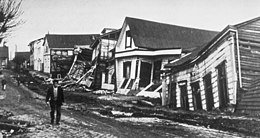The Devastating Impact of the 1960 Valdivia Earthquake
On May 22nd, 1960, the world witnessed an unprecedented natural disaster known as the 1960 Valdivia earthquake in Chile. This colossal seismic event, with a magnitude of 9.4-9.6, stands as the most powerful earthquake ever recorded. The epicenter near Valdivia in southern Chile bore the brunt of the destruction, leading to catastrophic consequences that reverberated across the region and beyond.
The geographical impact of the earthquake was vast, affecting areas such as Valdivia, Puerto Montt, and Concepción. The seismic waves caused widespread devastation, crumbling buildings, collapsing bridges, and severing roads. In Valdivia, the earth’s violent shaking resulted in the sinking of the ground, flooding parts of the city as rivers changed course. The infrastructure damage was profound, with numerous homes, schools, and hospitals reduced to rubble, leaving thousands of residents homeless.
The human toll was staggering, with the loss of life estimated between 1,000 and 7,000 people. Eyewitnesses recounted harrowing experiences as they watched entire neighborhoods vanish in an instant. The immediate aftermath saw a chaotic scramble for survival, with rescue operations hampered by the extensive damage to transportation and communication networks. Governmental reports highlighted the sheer scale of the disaster, noting the widespread displacement and the urgent need for humanitarian aid.
The earthquake’s impact extended far beyond Chile’s borders as it triggered a series of tsunamis that swept across the Pacific Ocean. These towering waves reached as far as Hawaii, Japan, and the Philippines, causing further destruction and loss of life. Coastal towns in Chile were particularly hard hit; the port city of Corral was almost entirely destroyed by the surging waters. Historical accounts and scientific analyses of the tsunamis revealed their paths and the incredible distances they traveled, underscoring the global reach of this catastrophic event.
In concluding the examination of the immediate impact of the 22nd May 1960 Valdivia earthquake in Chile, it becomes clear that this seismic event reshaped the landscape, altered lives, and left an indelible mark on history. The combination of the earthquake and subsequent tsunamis illustrated the immense power of natural forces and the vulnerability of human settlements in their wake.
Long-term Socio-Economic Consequences and Landscape Transformation
The impact of the 22nd May 1960 Valdivia earthquake in Chile transcended immediate destruction, leaving a lasting imprint on the region’s socio-economic fabric and physical landscape. The seismic event triggered significant geographical changes, including land subsidence and the formation of new water bodies, like lakes and lagoons. These alterations not only reshaped the natural environment but also redefined the living conditions and economic activities in the affected areas.
One prominent geographical change was the subsidence of large land areas, which resulted in the permanent flooding of low-lying regions. The creation of the Riñihuazo Lake is a notable example, formed when a landslide dammed the Riñihue River. The new water bodies and altered river courses required substantial adjustments in local infrastructure and land use. Agriculture, a critical part of the local economy, faced severe disruption. Farmlands were inundated, and the altered landscape necessitated new agricultural practices and crop selections suitable for the changed environment.
Industrially, the damages were profound. Valdivia, an essential industrial hub, saw its infrastructure crippled. Factories, mills, and transportation networks were decimated, leading to a sharp economic downturn. Reconstruction efforts were hampered by the extensive damage, and many industries took years to recover fully. The housing sector also experienced a significant crisis; nearly half of the homes in affected areas were destroyed or severely damaged, leading to a massive displacement of people and a prolonged housing shortage.
The socio-economic challenges faced by survivors were immense. Displacement, loss of livelihoods, and the psychological toll of the disaster created a complex humanitarian crisis. The Chilean government, with substantial international aid, launched extensive relief and reconstruction programs. These efforts included rebuilding infrastructure, providing housing, and restoring agricultural land. However, the recovery was uneven, and many communities struggled with chronic socio-economic issues for years.
Historical data, economic reports, and scholarly articles point to the earthquake’s enduring legacy. The transformation of the landscape and the socio-economic upheaval underscore the profound and lasting impact of the 1960: Valdivia earthquake in Chile. For a deeper understanding, readers may refer to detailed studies available in scientific journals and historical archives that document the extensive changes and recovery efforts post-disaster.

